Removing the head from the engine was discussed in the article - "Dismantling the cylinder head »
Disassembling the cylinder head in the article - "Disassembling the cylinder head"
In this article, we will consider checking and repairing the cylinder head.
We carefully flush the cylinder head and clean the oil channels of the head.
We remove carbon deposits from the combustion chambers and from the surface of the exhaust channels with a metal brush.
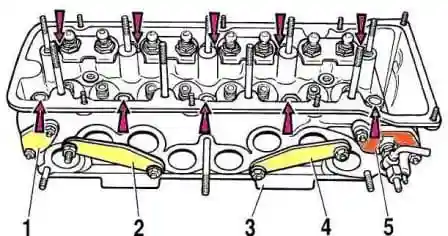
Inspecting the cylinder head. Cracks are not allowed anywhere in the head.
If there is a suspicion that coolant has entered the oil system, you need to check the tightness of the cylinder head.
To check the tightness, close the holes of the cooling jacket of the cylinder head with plugs.
There is a special set of plugs A.603334. But you can, of course, make it yourself from auxiliary materials.
Inject water at a pressure of 0.5 MPa (5 kgf/cm2) into the cylinder head cooling jacket with a pump.
There should be no water leakage from the cylinder head for two minutes.
You can check the tightness of the cylinder head with compressed air, for which you also install the plugs of tool A.60334 on the cylinder head.
Immerse the cylinder head in a bath of water heated to 60-80˚C and let it warm up for five minutes.
Then supply compressed air inside the head at a pressure of 0.15-0.2 MPa (1.5-2 kgf/cm2). Within 1-1.5 minutes, no air bubbles should escape from the head.
Valve seats
The shape of the chamfers of the valve seats is shown in figures 2 and 3.

- 2. Intake valve seat profile
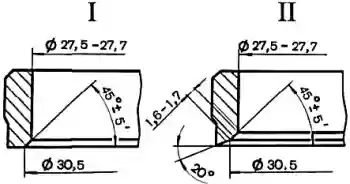
- 3. Exhaust seat profile
On the working chamfers of the seats (the contact area with the valves) there should be no pitting, corrosion and damage.
Minor damage can be repaired by grinding the seats, removing as little metal as possible.
Sanding can be done either by hand or with a grinder.
To grind the seats, place the cylinder head on a stand, insert the rod A.94059 into the valve guide and clean the chamfers of the seats from carbon deposits with A.94031 and A.94092 countersinks for exhaust valve seats and A.94003 and A.94101 countersinks for seats intake valves.
Sinkers are put on the spindle A.94058 and centered by the guide rod A.94059.
These rods are available in two different diameters: A.94059/1 for intake valve guides and A.94059/2 for exhaust valve guides.
Put the spring A.94069/5 on the guide rod A.94059, install on the spindle A.94069 the conical circle A.94078 for exhaust valve seats or the circle A.94100 for inlet valve seats, fix the spindle in a grinder and grind the seat valve.

- 4. Valve seat grinding

At the moment the wheel touches the seat, the machine must be turned off, otherwise vibration will occur and the bevel will be incorrect.
Recommended it is necessary to dress the wheel more often with a diamond.
For exhaust valve seats, bring the width of the working chamfer to the values indicated in Figure 2, using a countersink A.94031 (angle 20˚), and a countersink A.94092, which eliminates work hardening on the inner diameter.
The countersinks are put on the spindle A.94058 and, just like when grinding, they are centered with the rod A.94059.
At the inlet valve seats, bring the width of the working chamfer to the values indicated in Figure 3, first processing the inner chamfer with a countersink A.94003 (Figure 5) until a diameter of 33 mm is obtained, and then a 20˚ chamfer with a countersink A.94101 until a working chamfer is obtained 1.9-2 mm wide.
Valves and valve guides
Remove carbon from the valves.
Check whether the stem is deformed or cracked on the valve disc. Replace damaged valve.
Check the condition of the valve face. In case of minor damage, it can be sanded, maintaining a chamfer angle of 45°30′±5′.
In this case, the distances from the lower plane of the valve disc to the base diameters (36 and 30.5 mm) must be within the limits indicated in Figure 6
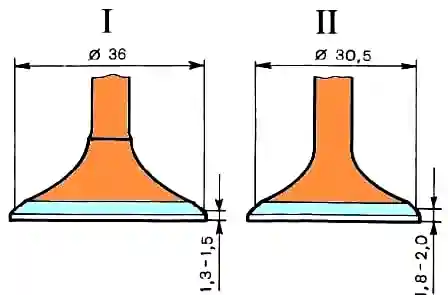
- 6. Dimensional limits for grinding valve chamfers
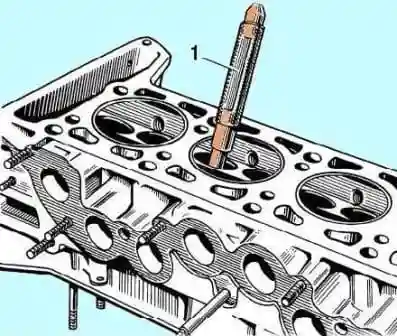
- 7. Pressing out guide bushings
Check the clearance between the valve guides and the valve stem by measuring both the valve stem diameter and the valve stem bore.
Estimated gap for new bushings: 0.022-0.055 mm for inlet valves and 0.029-0.062 mm for exhaust valves; the maximum allowable limiting clearance (during wear) is 0.3 mm, provided there is no increased noise from the gas distribution mechanism.
If the increased clearance between the guide bushing and the valve cannot be eliminated by replacing the valve, then replace the valve bushings using the A.60153/R mandrel for pressing out and pressing in (Figure 7).
Press the guide bushings with the retaining ring on until it stops against the body of the cylinder head.
After pressing, ream the holes in the guide bushings using A.90310/1 (for inlet valve bushings) and A.90310/2 (for exhaust valve bushings).
Always replace the oil deflector caps of the guide bushings with new ones when repairing the engine.
Change damaged valve stem seals with the cylinder head removed.
To press on the caps, use the mandrel 41.7853.4016.
Springs
Make sure that the springs are not cracked and their elasticity has not decreased, for which check their deformation under load (figure 8).

- 8. Basic data for checking the outer (a) and inner (b) valve spring
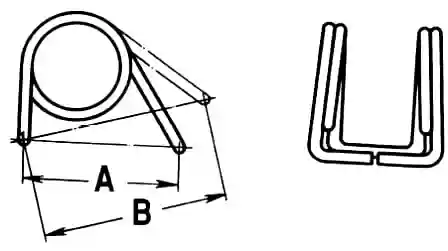
For lever springs (Figure 8), dimension A (spring in a free state) should be 35 mm, and dimension B under a load of 51-73.5 N (5.2-7.5 kgf) - 43 mm.
Cylinder head bolts
Repeated use of bolts will elongate them.
Therefore, check whether the length of the bolt shaft (excluding the length of the head) does not exceed 117 mm and, if it is longer, replace the bolt with a new one.
Valve levers
Check the condition of the working surfaces of the lever mating with the valve stem, with the camshaft cam and with the spherical end of the adjusting bolt.
If nicks or marks appear on these surfaces, replace the lever with a new one.
If deformation or other damage is found on the lever adjusting bolt bushing or on the bolt itself, replace the parts.





